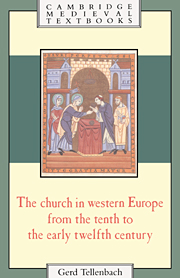Book contents
- Frontmatter
- Contents
- Translator's note
- Author's preface
- List of abbreviations
- 1 Western Christendom and its environment in the tenth and eleventh centuries
- 2 The church and its manifestations on earth
- 3 The material existence of the churches and the clergy
- 4 Religious life and thought
- 5 The beginnings of the revolution in church history
- 6 Gregory VII (1073–1085)
- 7 Continuing conflicts between established principles
- 8 Pope, church, and Christendom
- Epilogue
- Select bibliography
- Index
- Cambridge Medieval Textbooks
2 - The church and its manifestations on earth
Published online by Cambridge University Press: 05 June 2012
- Frontmatter
- Contents
- Translator's note
- Author's preface
- List of abbreviations
- 1 Western Christendom and its environment in the tenth and eleventh centuries
- 2 The church and its manifestations on earth
- 3 The material existence of the churches and the clergy
- 4 Religious life and thought
- 5 The beginnings of the revolution in church history
- 6 Gregory VII (1073–1085)
- 7 Continuing conflicts between established principles
- 8 Pope, church, and Christendom
- Epilogue
- Select bibliography
- Index
- Cambridge Medieval Textbooks
Summary
THE UNIVERSALITY OF THE CHURCH
Between the end of the ninth century and the decisive events of the eleventh there were hardly any serious, deeply divisive conflicts within Christianity. The Trinitarian disputes of late antiquity and the early middle ages were long forgotten; the echoes of Adoptionism concerned theologians and synods only briefly. The old struggles between Rome and the eastern patriarchates, Constantinople in particular, which flared up from time to time, hardly concerned most Christians either in the West or in the East. The controversies of the ninth centuries about the Eucharist and their consequences also hardly touched most Christians; they were confined to narrow channels. There was a general consensus about the nature of the church, and its daily liturgical life was in practice carried out in an impressive and essentially uniform manner, in spite of manifold peripheral variations. Nor were the roles of clergy and laity within the liturgy a matter of dispute, though they underwent some changes in this period.
Everywhere bishoprics and parishes formed the most significant context for the life of the church, which was a comparatively uniform one even though their internal formation had occurred at different times and under different circumstances and even though wars had occasionally led to breaks in continuity. The units above the level of the diocese, provinces or metropolitan districts, were gradually introduced everywhere, but their significance and coherence were very uneven both temporally and geographically.
- Type
- Chapter
- Information
- Publisher: Cambridge University PressPrint publication year: 1993



